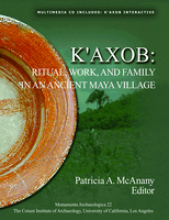K'axob: Ritual, Work, and Family in an Ancient Maya Village

Backlist
Series: Monumenta Archaeologica 22ISBN: 978-1-931745-09-3
Publication Date: Jun 2004
Price: Hb $68.00
Order this book here!
- Print: Order from our distributor
- Open Access: PDF
Return to catalog
Patricia A. McAnany
Shortly after 800 B.C., a village was founded in the wetland and riverine habitat of northern Belize. Now called K’axob, this Maya community grew and prospered through Formative and Classic times. A millennial-long record of Formative life has been investigated archaeologically by peeling back the closely stratified layers of superimposed domiciles. These houses, their domestic and mortuary features, and associated artifacts reveal a conscious construction of identity and shed light on the manner in which materiality was manipulated in response to larger political dictates. Longterm stasis in material remains suggests that artisan production played a key role in social reproduction, yet the manner in which access to key resources was increasingly localized intimates a political landscape of crystallizing hierarchies. Subfloor mortuary interments were spatially associated with cuisine-related features such as sherd-lined pits, reflecting a cosmology in which ritual and work were closely integrated. These insights and more are presented in individual chapters that examine the material remains of early K’axob. An accompanying interactive CD provides complementary materials on a scale never before achieved and includes comprehensive data sets, over one thousand images (both photographs and line drawings), a tour of K’axob, and 3-D models of the excavation units.
stratified layers of superimposed domiciles. These houses, their domestic and mortuary features, and associated artifacts reveal a conscious construction of identity and shed light on the manner in which materiality was manipulated in response to larger political dictates. Longterm stasis in material remains suggests that artisan production played a key role in social reproduction, yet the manner in which access to key resources was increasingly localized intimates a political landscape of crystallizing hierarchies. Subfloor mortuary interments were spatially associated with cuisine-related features such as sherd-lined pits, reflecting a cosmology in which ritual and work were closely integrated. These insights and more are presented in individual chapters that examine the material remains of early K’axob. An accompanying interactive CD provides complementary materials on a scale never before achieved and includes comprehensive data sets, over one thousand images (both photographs and line drawings), a tour of K’axob, and 3-D models of the excavation units.


